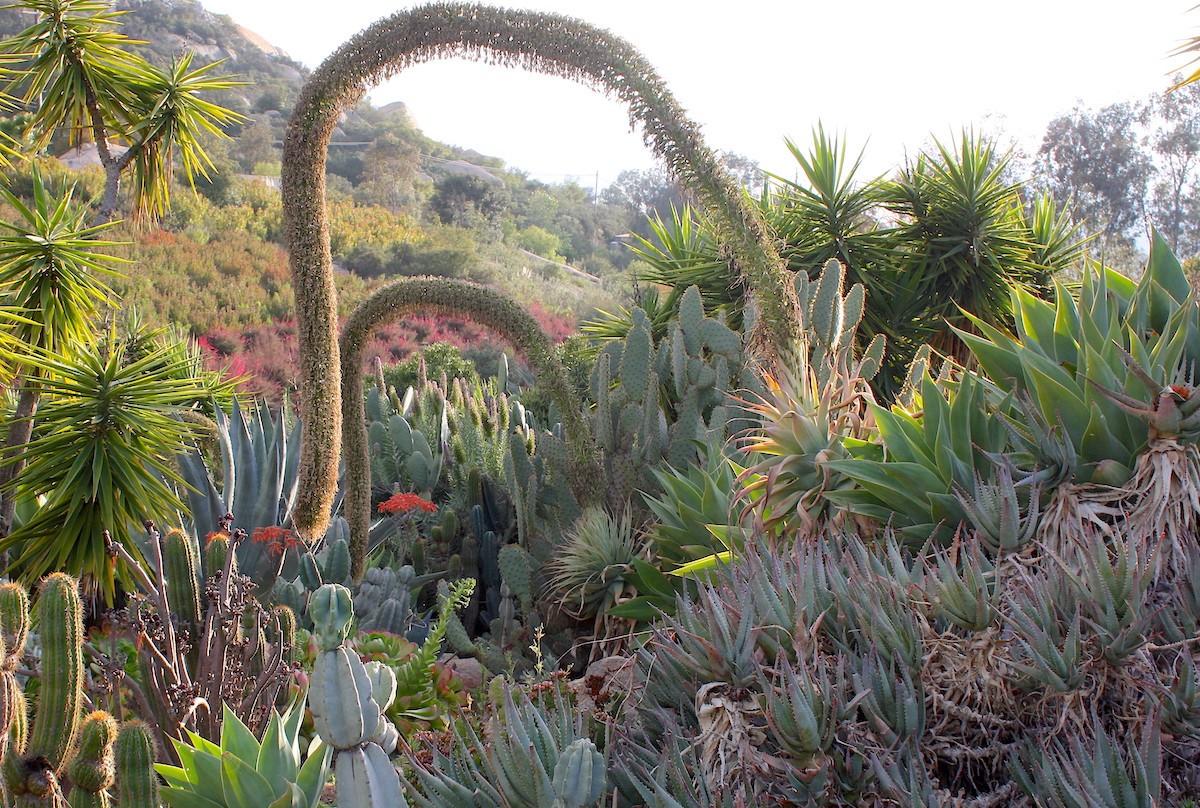
Agave attenuata (Foxtail Agave) Care & Cultivation
How do I love foxtail agaves (A. attenuata)? Let me count the ways:
-
- They've performed well in my garden for over 20 years. In pots too.
- Rosettes eventually attain a manageable 5' in diameter.
- Soft, flexible leaves lack barbs or points. Yes, a harmless agave!
- They're trunk-forming unlike other agaves, so they serve as beautiful backdrop plants and lend height to garden vignettes.
- Grown en masse, foxtails are useful as (and suggest) hedges of big green flowers.
- They're easy to propagate (see how in the video) and grow in climates other agaves won't.
- There's even a simple, fun and clever way to decorate foxtails for the holidays!
How Foxtails are Different (and Better)
The species name attenuata refers to the leaves, and means “tapers gradually to a point.” Well so do the leaves of all agaves. It might have been better to give it a Latin name that means soft-leaved, thin-leaved or lacking spines. Oh well.
Agave attenuata also is unusual in that it does well in humid, semitropical regions of the US. A photo in my book Designing with Succulents (2nd ed., p. 145) shows foxtails in Hilo, Hawaii.
And these I saw in a garden in Paradise Valley near Phoenix --

Foxtail agaves (Agave attenuata) in Arizona
The farther east from the Pacific Ocean, the more these thin-leaved succulents are susceptible to frost in winter and sunburn and heat stress in the summer. In such situations, they’re best grown under trees that provide a lacy canopy and diffuse strong sun. To keep such understory foxtails tidy, hose the centers of the plants occasionally to remove fallen leaves. They'll appreciate the extra water, too.
Foxtails make a nice border for paths and driveways, but keep in mind they will grow in the direction of greatest sunlight. Since they're trunk forming, they may eventually lean where you don’t want them. In the video you'll see one being repositioned.

Foxtail agaves naturalized on a Laguna Beach, CA cliffside.
That big, bushy stalk
Agave attenuata is from central Mexico and rare in the wild. Typical of agaves, it blooms once in its lifetime, then dies. Bloom stalks form in midwinter, attain maturity by spring, and are unbranched and arching. Their bushy look led to the name "foxtail agave." Buds that line a stalk that emerges from the center of the plant open into chartreuse flowers with long stamens and pistils.

This streetside colony, shown in bloom in December, was later destroyed by the plants' main pest: agave snout weevil. To prevent snout weevil, drench agaves two or three times a year with pre-emergent insecticide. Learn more.
In early December, my neighbors decorate the tips of foxtail bloom spikes when they’re still easy to reach. By Christmas, the ornaments are high overhead (I show them in the video).
Incidentally, you don’t have to let the stalk grow. Cutting it off won’t save the plant from dying, but you won’t have a long stalk to get rid of of later on. Moreover, a truncated stalk may produce a mass of offsets, which can look cool and also be harvested and planted.
How to Propagate Foxtail Agaves
Flowers along the stalk mature into miniatures of the mother plant. When they’re teacup sized or larger and come off easily, plant them in a tray of coarse potting mix. Keep out of direct sun in barely moist soil until the little plants root, then transplant them into larger pots.
That’s fairly easy, but there’s an even better way to propagate Agave attenuata, and you don’t have to wait for it to bloom. All you need is colony of the plants (if you don't have one, a friend or neighbor likely does). At any time of year, it’s possible to remove offsets that grow on the trunk or at the base of a rosette.

To remove Agave attenuata offsets along the trunk, gently wiggle them off. See how.
The larger these little clones are, the more likely they have aerial roots. In the video, I harvest one and get it off to a good start in a nursery pot. In six months or so I'll plant it in the garden. They make great gap-fillers.
When repositioning Agave attenuata, all it needs is enough trunk to anchor it. Typical of stem succulents, roots will grow from a stub. Also like most succulents, foxtails are not fussy about soil as long as it drains well.
The biggest mistake people make when moving or replanting Agave attenuata as a cuttting is assuming they need a long trunk (and consequently a narrow deep hole).
Step-by-step:
- Trim off any dead lower leaves prior to taking a cutting (removing a rosette).
- Cut the trunk straight across 4 to 6 inches below the lowest leaves
- Prepare the soil and dig a shallow cylindrical hole the size of the nubbin of trunk below the rosette
- Set the cutting upright in its new location.
- Protect from excessive sun by draping it with shade cloth (important in the summer months).
- Like most succulent cuttings, it'll feed off its tissues while forming new roots.
- Discard the rest of the trunk.
- New growth may form from the decapitated trunk if it's rooted in the ground. Remove it if that's now what you want.
Pests and Problems
Foxtails are seldom bothered by pests, except for one. I used to think that agave snout weevils left them alone, but unfortunately that’s not the case. You’ll need to treat your foxtails preventatively, as you routinely do your other agaves. Learn more about snout weevil treatment and prevention.
Deer may significantly damage foxtail agaves, especially when food is scarce. Snails can be a problem too. I use Sluggo snail bait, because it kills the pests but doesn’t harm pets or wildlife.
Beige patches on leaves indicate sunburn. If the weather suddenly changes from weeks of cool overcast to temps above 80 and full hot sun, drape foxtails that are out in the open with lightweight fabric or shade cloth. The plants typically acclimate in about a week.
Seasonal threat to foxtail agaves
Because they're not cold-hardy, frost will cause long-lasting damage. I’m in Zone 9B, between Southern California’s coast and desert. I cover my foxtails with frost cloth when freezing temps (32 degrees and lower) are forecast. Learn more: Cold-Weather Care for Succulents.
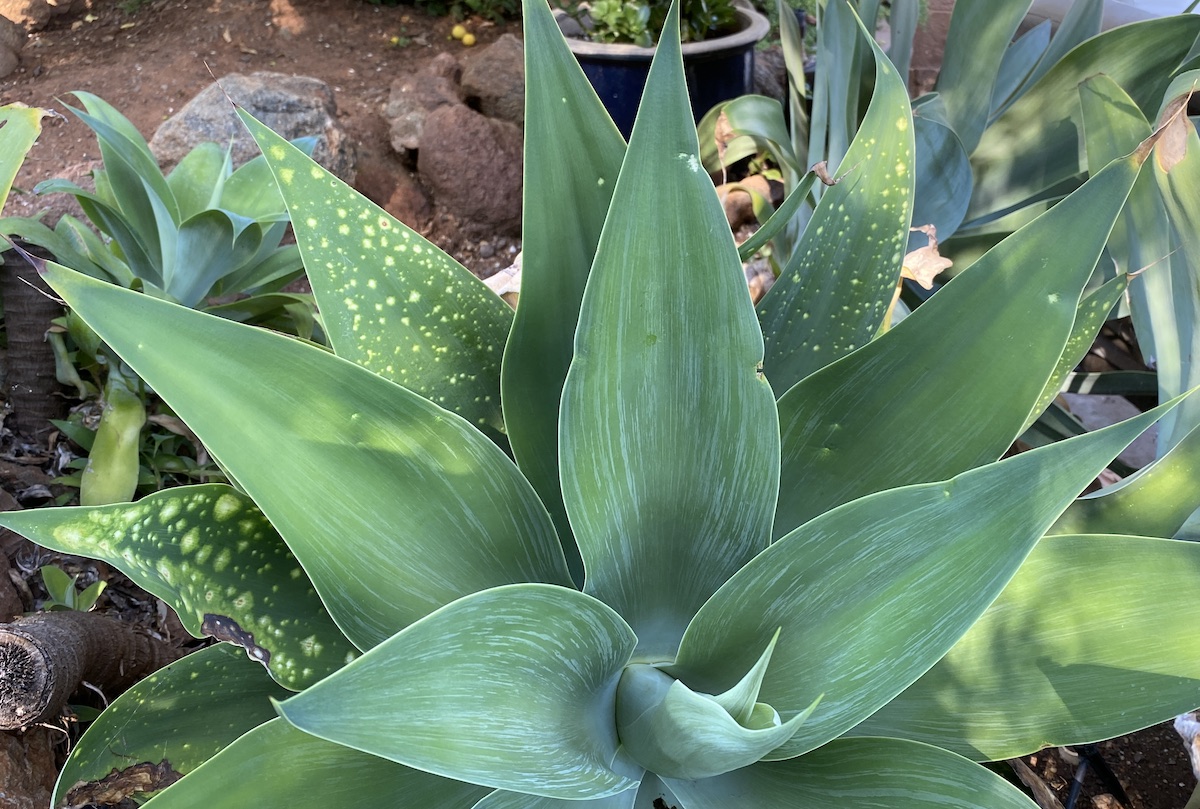
White spots on foxtail agaves result from impact damage, typically hail
The question I get asked most often about foxtail agaves is what these tiny white spots are. It’s hail damage, which people generally notice a week or more after a storm. Such pitting won't heal, but it doesn’t hurt the plants and in a few months will be barely noticeable. Typical of rosette succulents, new leaves that grow from the center of the plant hide imperfect older ones.
Gorgeous Variegates and Cultivars
Forms of Agave attenuata with blue-gray leaves include Agave attenuata 'Boutin Blue' and 'Nova'. These may (but not always) have shorter, broader leaves and erect rather than pendant flower stalks.

Agave attenuata 'Boutin Blue'
Variegates of Agave attenuata are prized by home gardeners and collectors alike. Just know that light-colored or striped plants tend to be weaker due to less chlorophyll. Named hybrids of Agave attenuata ‘Variegata’ include ‘Kara’s Stripes’ and ‘Ray of Light’.
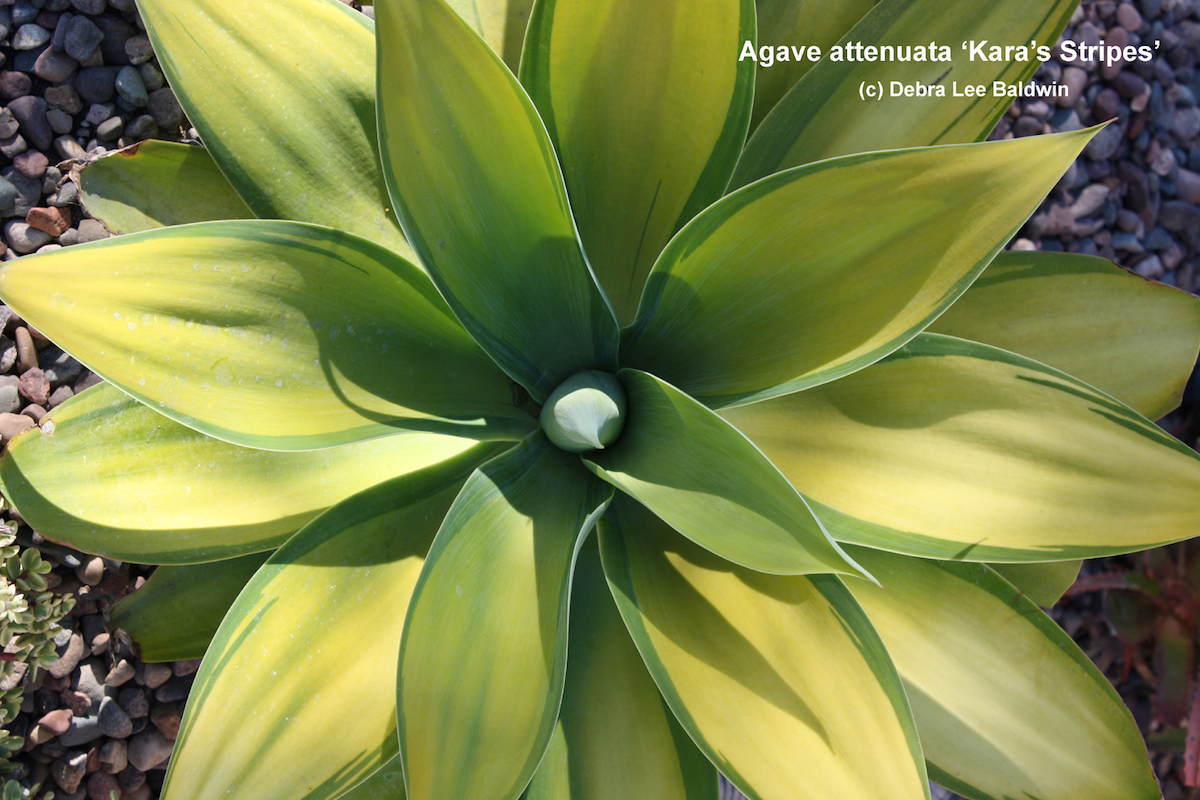
Agave attenuata 'Kara's Stripes'
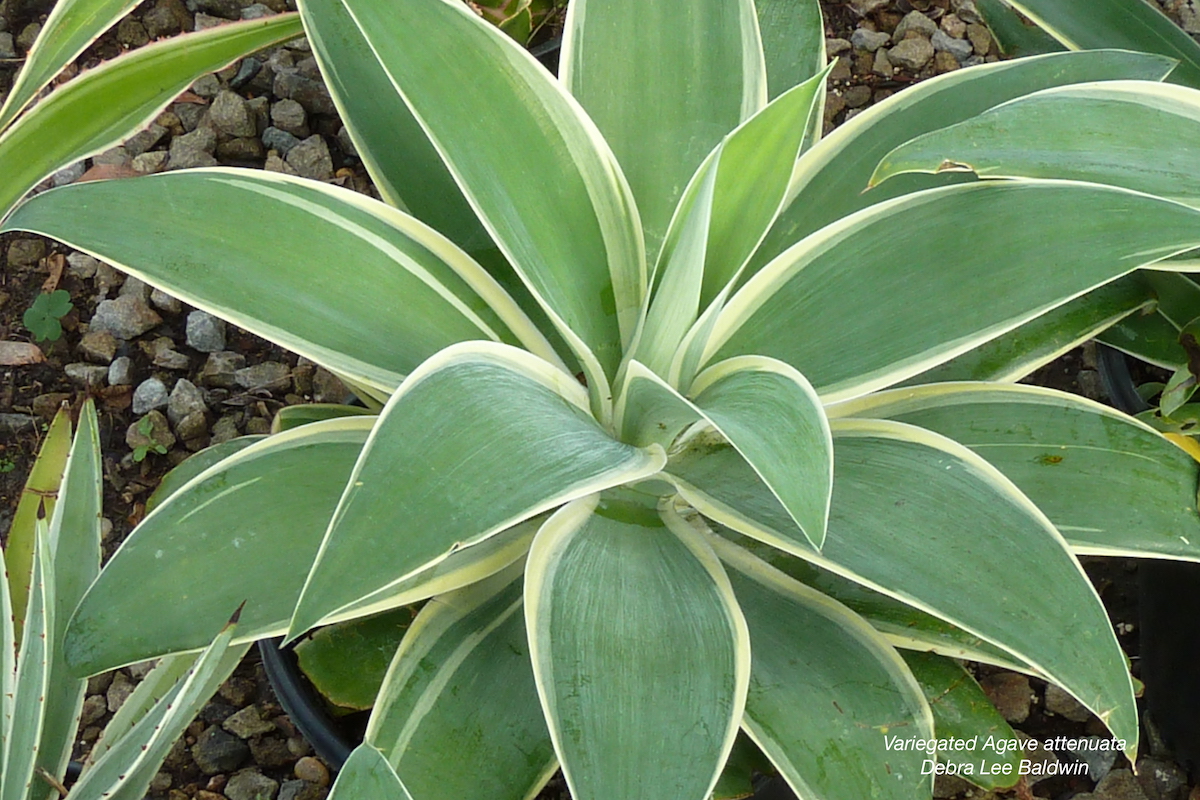
Agave attenuata 'Ray of Light'
Plants started from seed resemble their parents and each other, but will vary just as no two siblings are alike. Agave attenuata variegates seldom offset, are tricky to tissue culture, and take a decade or more to bloom (if ever). Such propagation challenges make them rarities, but eventually---due to consumer demand---we'll likely see more of them in nurseries.
In the early 1960s, hybridizer David Verity of UCLA's botanical garden crossed Agave attenuata with Agave shawii, resulting in Agave ‘Blue Flame’. Its smooth, flexible leaves lack teeth on their margins and curve inward, making the terminal spines less treacherous.
Later on, San Diego hybridizer Kelly Griffin crossed Agave attenuata with Agave ocahui, resulting in Agave ‘Blue Glow’. It's become one of the most popular landscape succulents, often planted in multiples because of its manageable size (3 feet in diameter), painterly colors, perfect symmetry, and solitary, nonpupping habit.
Here both are shown together at Succulent Gardens nursery south of San Francisco. Btw, this is one of my favorite photos ever. If you love it too, it's available as a note card and stretched canvas print at Succulent Chic, my online store.
Related Info on This Site
Agave Snout Weevil Prevention and Treatment
Agave snout-nosed weevil is a half-inch-long black beetle with a downward-curving proboscis that enables it to pierce an agave’s core, where it lays its eggs. Grubs hatch, consume the agave’s heart, then burrow into the soil to pupate.
Your Agave’s Blooming–Now What?
Your agave is blooming! Now what? In my new video, Q&A and photo gallery you’ll find expert advice, agave IDs and how to start the plants from seeds and bulbils.
Protect Your Succulents From Rain, Hail, Frost
Prolonged damp and cold are death to succulents. Rot begins in the soil and goes up the trunk. Tissues soften, turn dark, and leaves fall off.
Agaves: Uses, Photos, IDs and Varieties
With the exception of a few soft-leaved and variegated varieties, agaves want sun—the more the better in all but desert climates. Most are hardy to the mid- to high-20s F, and some go a lot lower. Sharp points at leaf tips and along leaf edges can make agaves treacherous. I snip about a quarter inch from leaves’ needlelike tips with garden shears.


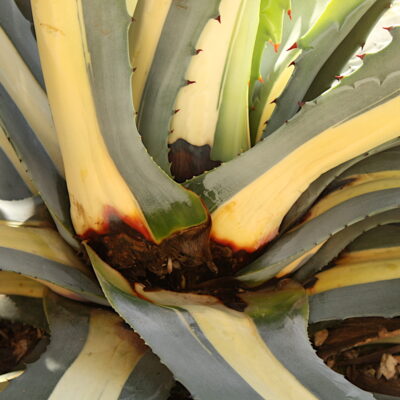
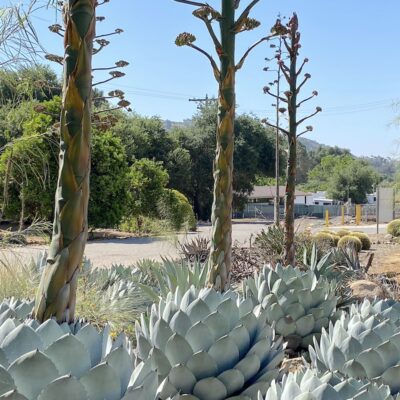
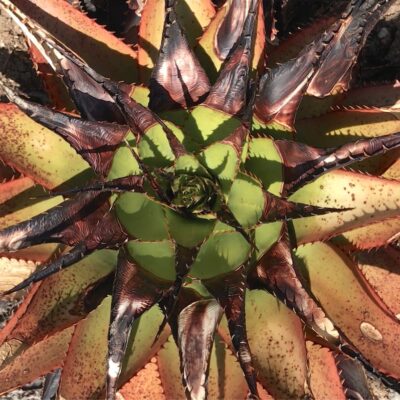
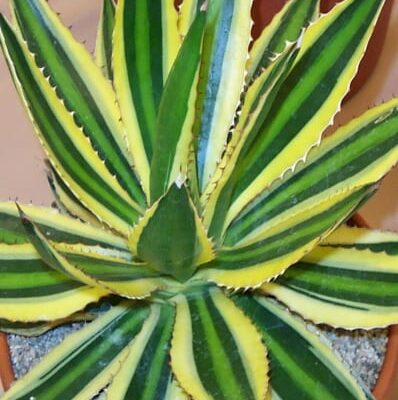
Hi Debra!
I love this agave, especially for its *tropical* sensibility. In RB I gave up growing it on our unprotected slopes, but I love the potted versions on the covered patio. Keeping the plants in smaller pots also controls the size for me. I do like to underplant the agave with a low-growing succulent ground-cover. About every 2 years I cut the trunks and repot. (No “foxtails” yet …)
Thanks so much … really informative video!
Marilyn Chaffee
Thank you Marilyn — I completely agree. Sounds like you understand Agave attenuata perfectly and are making it work in your microclimate. So interesting about cutting the trunk and repotting about every two years. Great idea. Seems counterintuitive (nurturing gardeners worry about harming plants), but hey, they don’t mind!
I received a packet of mixed agave seeds which I grew for use as houseplants here in Illinois but was a little disappointed with this variety because of the plain, thin, pale leaves as opposed to others. As they grew I found that the leaves easily tattered and tore in moving pots around but I can see the potential in growing a large, perfect specimen plant in a large pot.
Hi Donald, I admire your perseverance, and I hope that seed-starting is fun for you. After all, it could take years to get a decent-sized specimen. Here in CA we’re way too impatient, and we have the luxury of agaves everywhere, all sizes, kinds and rarities. I don’t say that to make you envious. But I’m curious, what with mail-order nurseries that offer agaves, and if it’s a large, perfect specimen plant is your goal, why you don’t simply order a pup or small rooted specimen online.
Hi Debra,
What do you do with an agave that has partly fallen over with a large pup off to the side of the parent plant ?
Do I cut and remove the main plant or cut off the trunk and replant the parent plant like you did in the video?
I will have to move the pup to a pot since I don’t want a huge group of agave A.
Thank you..
Hi Elaina — You can do any of that. Agave attenuata is very accommodating. I’d base the decision on the space you have to fill and the aesthetics of how it looks. Sort of like a living floral arrangement.
Hi, is it necessary to have the branch callous over before replanting? Thanks!
Hi Christina — To be honest, when it comes to common succulents (which I consider this one) I don’t bother. However, if it’s important to you, let it sit until the cut end is no longer wet and raw. It’s more vulnerable to bacterial and fungal infection. It just takes a day or so for it to heal.
Hi!
Would it be possible to put aerial roots in soil and cut the trunk?
I was gifted a foxtail agave some years ago, but I live in Pennsylvania, so he’s strictly potted. The problem is he’s now almost as tall as I am and requires a huge pot. The pot size isn’t a huge deal, but the height makes it impossible to transport without a truck. I’ve had him (I named him Fred) for 8 years and really don’t want to accidentally kill him.
Thank you!
Hi Juli — Alas poor Fred, bigger than he needs to be and it’s not cause for celebration. If you’re asking if a new plant will grow from a beheaded trunk, it’s possible, but risky. The still-rooted trunk may grow nodes that produce tiny plants, or it may not recover. On the other hand, you can cut Fred’s trunk about six inches below the base of the rosette and replant it (stand it upright in a pot and add soil), and there’s a good chance it’ll root. Why not do both?
Hi Debra, thank you for sharing your expertise. I have several bunches of agave attenuata in my “parkway” in Los Angeles and in my small yard. The smaller pups and stalks are full and healthy but the larger heads are unfortunately prone to damage by cars parked on our street and the larger heads are encroaching on the sidewalk. I’ve also sadly underwatered them (in an effort not to overwater them…I’m working on a better balance), and some of the larger heads have yellow/brown edges. I’d like to keep them looking healthy and not let the size get out of control, as well as keep them from being damaged by cars or bugging my neighbors. Can I just remove the larger heads when necessary? If so, what tool should I use, and what do you suggest I do with the heads if I don’t have a place for them? I feel guilty pruning them so severely. Any suggestions would be helpful. Thank you!! Pam
Hi Pam — Any kind of pruning saw will work. The trunks are easy to saw through. You might put the larger heads on the curb with a sign that says “free.” If no one takes them, then discard in the green waste or perhaps take them to a succulent swap. Prune low so that the cut trunk shows as little as possible. It may sprout new offsets, which will fill the gap. Or others that are smaller may do so over time. The leaves are easily trimmed to remove damage. Use a pair of scissors and cut each leaf to a point. See how in my Agave attenuata video.
My foxtail has, I swear, one large bloom from the middle, as it should, and two small ones coming out from two different leaves. Is this unusual? I have two more foxtails that just have the normal one large bloom.
Hi Nancy — It’s unusual, but not unheard of. The plant is gearing up for reproduction, and if something happened to stimulate growth in one or more leaf axils (usually some kind of damage that caused the tissues to grow new cells), it may send up additional bloom stalks. You can actually cause this to happen by cutting off the bloom stalk where it emerges from the center of the rosette…not only with agaves, but other succulents as well (like paddle plant, Kalanchoe luciae).
Thank you. The little ones are growing very fast. Very interesting. Thanks for the quick replay.
Thank you for this video. I live in IN and keep my agave attenuata potted and move it outside in the summer. It has grown quite tall and sadly got too heavy and fell over last week. The top/center of the crown broke off. What do I do next? Can i propagate the broken piece? Thanks for any advise. I love this plant and had had it for many years
Hi Nancy — You can propagate what remains of the agave, but not the broken center core. Cut off the stem about 6 inches below the lowest leaves and plant the rosette in fresh soil, so the bottom leaves are resting on the rim of the pot. Roots will form from the stem. As a bonus, new little offsets may form in the center, which looks pretty because they’re framed by the remaining larger leaves. This is actually called “coring,” which is what growers of rare succulents do, when they want offsets they can remove and plant.